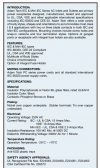I recently reviewed the Buckeye Hypex NC502MP based 8 channel amplifier. This is a follow up teardown. Let's start with the shot of the Hypex amplifier in situ:

You see the vertically mounted amplifier module which provides the power supply and class D amplification for two channels. The capacitor brands are Aishi is which is a decent second tier capacitor. Rating is 105 degrees C which is nice. Here is a beauty shot of all the amplifier modules:

The heatsink and mounting seems quite stout so I am not too worried about heat dissipation. It may actually work better than screwing them flat on the bottom of the box as is commonly done in less dense configurations.
Wiring is clean because there is a vertical board which houses all the XLR inputs and then ribbon cables carry the signal to the amplifier. There is a label on an IC above with Buckeye branding. I am assuming it is a small microprocessor to unify the status of the amplifier/protection circuit for all the modules (there is only one indicator in front). Speaker terminals are direct connected with spade connectors. I have recommended to use heavier duty ones to Buckeye and he tells me that the current production is using such.
On the left side you see the AC wiring loom which is nicely kept away from signal lines. It is also correctly zip tied to the bottom of the case. Here is a shot of where they go:

Two modules go to one AC inlet. Nice to see the wires twisted here although I don't know that it is necessary. These terminals were heavy duty.
The fuses are built into the IEC socket:

As I noted, the rating is 10 amps at 250 volts. This is fine for running at 250 volts but for 120, I would like to see 15 amp rating.
EDIT: as clarified later by the company, the sockets are actually rated at 15 amps by UL so it is fine.
Conclusions
Good design leads to a clean layout and implementation here. Not much to be concerned about other than upping the rating of the IEC sockets. I like the lack of clutter which should ease servicing. The custom PCB and microprocessor adds value here vs what you could build yourself in providing input connectivity and unified control.
-----------
As always, questions, comments, recommendations, etc. are welcome.
Any donations are much appreciated using: https://www.audiosciencereview.com/forum/index.php?threads/how-to-support-audio-science-review.8150/
You see the vertically mounted amplifier module which provides the power supply and class D amplification for two channels. The capacitor brands are Aishi is which is a decent second tier capacitor. Rating is 105 degrees C which is nice. Here is a beauty shot of all the amplifier modules:
The heatsink and mounting seems quite stout so I am not too worried about heat dissipation. It may actually work better than screwing them flat on the bottom of the box as is commonly done in less dense configurations.
Wiring is clean because there is a vertical board which houses all the XLR inputs and then ribbon cables carry the signal to the amplifier. There is a label on an IC above with Buckeye branding. I am assuming it is a small microprocessor to unify the status of the amplifier/protection circuit for all the modules (there is only one indicator in front). Speaker terminals are direct connected with spade connectors. I have recommended to use heavier duty ones to Buckeye and he tells me that the current production is using such.
On the left side you see the AC wiring loom which is nicely kept away from signal lines. It is also correctly zip tied to the bottom of the case. Here is a shot of where they go:
Two modules go to one AC inlet. Nice to see the wires twisted here although I don't know that it is necessary. These terminals were heavy duty.
The fuses are built into the IEC socket:
EDIT: as clarified later by the company, the sockets are actually rated at 15 amps by UL so it is fine.
Conclusions
Good design leads to a clean layout and implementation here. Not much to be concerned about other than upping the rating of the IEC sockets. I like the lack of clutter which should ease servicing. The custom PCB and microprocessor adds value here vs what you could build yourself in providing input connectivity and unified control.
-----------
As always, questions, comments, recommendations, etc. are welcome.
Any donations are much appreciated using: https://www.audiosciencereview.com/forum/index.php?threads/how-to-support-audio-science-review.8150/
Last edited:


